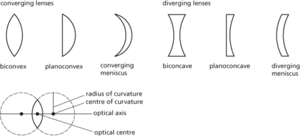A curved, ground, and polished piece of glass, moulded plastic, or other transparent material used for the refraction of light. A converging lens is one that brings the rays of a parallel beam of light to a real principal focus. They include biconvex, planoconvex, and converging meniscus lenses. Diverging lenses cause the rays of a parallel beam to diverge as if from a virtual principal focus; these include the biconcave, planoconcave, and diverging meniscus lenses.
The centre of curvature of a lens face is the centre of the sphere of which the surface of the lens is a part. The optical axis is the line joining the two centres of curvature of a lens or, in the case of a lens with one plane surface, the line through one centre of curvature that is normal to the plane surface. The optical centre of a lens is the point within a lens on the optical axis through which any rays entering the lens pass without deviation. The distance between the optical centre and the principal focus of a lens is called the focal length (f). The distance (v) between the lens and the image it forms is related to the distance (u) between the lens and the object by the lens equation:
provided that the real-is-positive convention is used. This takes distances to real objects, images, and foci as positive; those to virtual objects, images, and foci as negative. The equation does not always apply if the alternative New Cartesian convention (see sign convention) is used.

Lenses.
A transparent optical element, either glass, crystalline, or plastic, that refracts light to form an image. A lens has either concave or convex surfaces, so that parallel light which strikes it is refracted either towards the focal point, as in a converging lens, or away from it, as in a diverging lens. A lens which is thin compared with its diameter will have a more distant focal point (i.e. a longer focal length) than a thicker one, will be easier to manufacture, and will suffer less from chromatic aberration and spherical aberration. In practice, to reduce these and other distortions, combinations of lenses, known as compound lenses, are used. See also achromatic lens.
A transparent biconvex structure in the eyes or analogous organs of many animals, responsible for directing light onto light-sensitive cells. In vertebrates it is a flexible structure centred behind the iris and attached by suspensory ligaments to the ciliary body. In terrestrial species its main function is to focus images onto the retina. To focus on near objects, the circular muscles in the ciliary body contract and the lens becomes more convex; contraction of the radial muscles in the ciliary body flattens the lens for focusing on distant objects (see also accommodation). The transparency and refractive properties of the lens are maintained by structural proteins called crystallins.
- Emin Pasha (1840–92)
- emirate
- Emirates, Fulani
- emission
- emission line
- emission nebula
- emission permit
- emissions
- emissions credits
- emission spectrum
- emission taxes
- potentially hazardous asteroid
- potential output
- potential reserve
- potential temperature
- potential transformer
- potentiation
- potentiometer
- potentiometric surface
- potentiometric titration
- pot-hole
- pothole
- potlatch
- potometer
- POTS